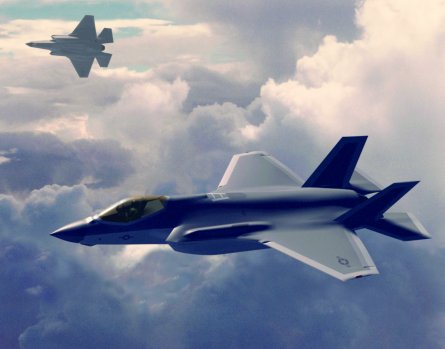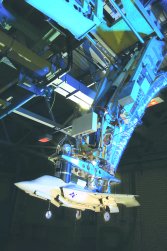By Graham Warwick in Fort Worth
Additional reporting by Guy Norris
In late October, five years after Lockheed Martin won the Joint Strike Fighter (JSF) competition, the first F-35 is expected to take to the skies over Fort Worth, Texas. By then, the eight international partners in the US-led development programme should be well along their national political paths to a decision on whether to sign up for the next phase, launching a global effort to build and support more than 3,000 aircraft.
As that first F-35, aircraft AA-1, sits in a hangar alongside the ramp at Fort Worth being prepared for flight, the programme has entered a critical phase. Political decisions in the USA and abroad over the next few months will determine whether the JSF will be given a chance to fulfil its advertised potential to be an affordable, interoperable fighter flown in three variants by the air arms of nine or more allied nations.
All is not quite as it seems on the surface. Rather than the first of many, AA-1 is a one-off, orphaned by a redesign to reduce the weight of the short take-off and vertical landing (STOVL) version that irrevocably changed the conventional take-off and landing (CTOL) aircraft and the carrier variant (CV), and added 18 months to the programme. The first “optimised airframe” F-35 is now scheduled to fly in February 2008.
Under the system development and demonstration (SDD) contract awarded in October 2001, Lockheed and partners Northrop Grumman and BAE Systems are developing three JSF variants – the CTOL F-35A, STOVL F-35B and CV F-35C – while under separate contracts Pratt & Whitney is developing the F135 primary engine and the General Electric/Rolls-Royce Fighter Engine Team is developing the F136 alternate engine. R-R is also developing the shaft-driven lift fan, three-bearing swivel nozzle and roll posts that comprise the STOVL lift system.
|
|
|---|
| The CTOL F-35A is in detail design. |
Design refined
Rather than a setback, Lockheed portrays the efforts of the STOVL weight attack team (SWAT) as a valuable opportunity to refine the design through one more iteration. And, in addition to an extra year of engineering, the replan also changed the manufacturing sequence for the development aircraft, grouping each of the variants in turn and providing an opportunity to move down the learning curve during assembly.
“Although painful, the weight-reduction effort has benefited all of the aircraft,” says Bobby Williams, air vehicle team lead. “SWAT put a schedule delay in the programme, and allowed us to take a design that was pretty good and refine it through another iteration.” As a result of the redesign, he says, the aircraft is much more maintainable, as well as lighter. “We got 3,000lb [1,369kg] out of the aircraft – and weight equals affordability.”
The redesign began in late 2003, just two years into SDD, when it became clear the STOVL variant’s weight problems “were not going to disappear through hard work – we had to step back and do things differently”, says Williams. The SWAT involved around 500 engineers in a dedicated effort, plus stand-downs by other large groups, and generated several thousand ideas that were then sorted through and studied.
Design changes adopted range from the major, such as revising the way the airframe subassemblies are mated, to the relatively minor, such as going from a single nosewheel door to two. “It turned out that in the 25kt [46km/h] crosswind case the single door acted as sail, and its moment arm sized the vertical tail,” says Tom Burbage, Lockheed Martin executive vice-president and general manager F-35 programme integration. “Going to double doors reduced the sail area and we got 40lb out of the vertical tail.”
Some of the changes were limited to one variant, such as resizing the internal weapons bays on the STOVL aircraft around a 450kg, rather than 900kg JDAM precision-guided bomb. While others, such as a new generator technology that saved 57kg, applied to all three. And not all of the changes were weight reductions: reshaping the auxiliary inlet lip on the STOVL variant generated 600lb (2.7kN) of additional thrust, says Williams.
Certain changes to save weight also improved other aspects of the design. “Going from a single-piece wing skin to more traditional multi-piece made it easier to optimise thickness using steps, but it also provided better access,” says Williams. “There was equipment on the upper side of the engine that you could not get to without removing the engine or nacelle. Now we can access them through the upper skin.”
|
© BAE Systems |
|---|
| Inlet refinements increased STOVL thrust |
Trading work
Changing the way the wing mates to the fuselage to reduce weight had a significant impact on who builds what pieces of the aircraft. “We gave up a bit of the key structure to Lockheed Martin to do what was right for the execution of the aircraft,” says Janis Pamiljans, Northrop’s F-35 programme manager. The company’s workshare was not rebalanced in terms of structures or systems, he says, adding that this is irrelevant as “we share a common award fee pool in which the three partners share an award fee equally”.
With structural design of the STOVL aircraft almost complete, weight is 0.5% under predictions and the team is positive of meeting its target. “We are confident the design is solid and robust, and we have capability to handle weight growth planned in – we not at the hairy edge,” says Williams. “We are very confident STOVL is going to work for us. A couple of years ago it was questionable – now we are there.”
Now the experience gained designing the F-35B is being rolled over into the F-35A. “With the lessons out of STOVL we are in great shape for weight on CTOL,” says Williams, who expects a “fairly uneventful” detail design phase for the F-35A. The F-35C is at the front end of detail design. One recent change to the CV aircraft was an increase in wing size to reduce carrier recovery speed. This and other changes to increase fuel capacity and reduce drag pushed the F-35C’s radius of action close to 1,300km (700nm) – “100nm more than the requirement”, he says.
Inevitably, the design changes mean the variants are now less common than originally envisaged. “The structure is less common, but not by a lot,” says Williams. “Some STOVL changes are not carried over, so as not to penalise the CTOL and CV with the most costly weight reductions. But we maintain a high degree of commonality where it matters most – in the mission system. That is what is expensive to test, and what gets maintained and upgraded over the life of the aircraft, and it is nearly 100% common.”
The concept of cousin parts has been maintained – the 7g-stressed F-35B may have thinner, lighter bulkheads than the carrier-capable F-35C or 9g-capable F-35A, but the difference is not visible, says Williams. There are also cousin parts in the systems: the electro-hydrostatic actuators on the power-by-wire flight controls are different sizes – the STOVL actuators were downsized to reduce weight, while the CV’s are bigger to provide higher control rates for low-speed approach – but they are all manufactured by the same supplier using the same process, he says.
“I think we have struck the right balance, and paid attention to ensuring that each of the variants meets the requirement while providing commonality for affordability,” Williams says. “The long-term cost is in maintaining the avionics – we pay for that once and apply it to all the variants.”
Avoiding pitfalls
Lockheed is keen to avoid the pitfalls of its F-22 programme, including the issues with avionics software instability that slowed flight testing. One reason for the problems, Burbage says, was the event-based software architecture mandated for the F-22. “We have gone back to a time-based system like the F-16 Block 60,” he says. While this architecture is more resilient and tolerant, an “extraordinary effort” is under way to ensure software ground testing is as close to a realistic flight environment as possible.
“All the sensors are running in the lab in a stressed environment, trying to force anomalies. They are running for up to 50h at a time,” says Burbage. The mission system hardware and software will be integrated and tested on the ground in the laboratory, then in the air in a Boeing 737 flying testbed, before it flies in the F-35.
Software is being developed in stages, building from around a million lines of basic vehicle-system software in the Block 0.1 release that will fly in AA-1 to a total of 6 million lines of code with the full-up Block 3 mission system. The same operational flight program (OFP) will be used by all three variants. “There will be one release to the aircraft – the aircraft will know if it is a CTOL, STOVL or CV; the engine will know if it is an F135 or F-136,” says Burbage. “We will release one OFP to the entire fleet; that way we will get economies of scale in software maintenance.”
As AA-1 is prepared for flight, Burbage is tracking “four or five critical paths”, including engine control software. Another, the helmet-mounted display (HMD), is not expected to be available for first flight. “We have protected and parallel paths – protected we must have for first flight; parallel we could support, but are not counting on,” says Williams. “HMD is on the parallel path.”
The F-35 is “helmet-centric”, Burbage says, but development of the HMD is proving a challenge. The biggest issue is clearing the helmet for ejection at 600kt while staying within the neck-load limits of the smallest pilots, he says, adding: “We are developing this for the broadest pilot population ever.”
Gearing up
Issues aside, the JSF is gearing up to begin risk-reduction flights with aircraft AA-1 as a pathfinder for the F-35s that will follow it into the air with gathering pace from early 2008 onwards. As the concurrency between development and production comes under critical scrutiny in US Congress, Williams believes the F-35 is in better shape than the F-22 was at this stage in its development. “Early in the F-22 programme, funding constraints led to cuts in risk reduction and laboratory investment. The F-35 is not funding constrained and investment at the right level in risk reduction and laboratories has put us on a much more solid footing.”
A successful flight of AA-1 in late October is likely to boost the F-35’s standing as the eight international partners in the JSF programme draw close to decisions on whether to sign the memorandum of understanding (MoU) on production, sustainment and follow-on development as planned in December. Signing the MoU will not commit any of the partners to buying the F-35, but it will start the global supply chain rolling and boost the JSF’s chances of fulfilling its potential. ■
Source: Flight International


















